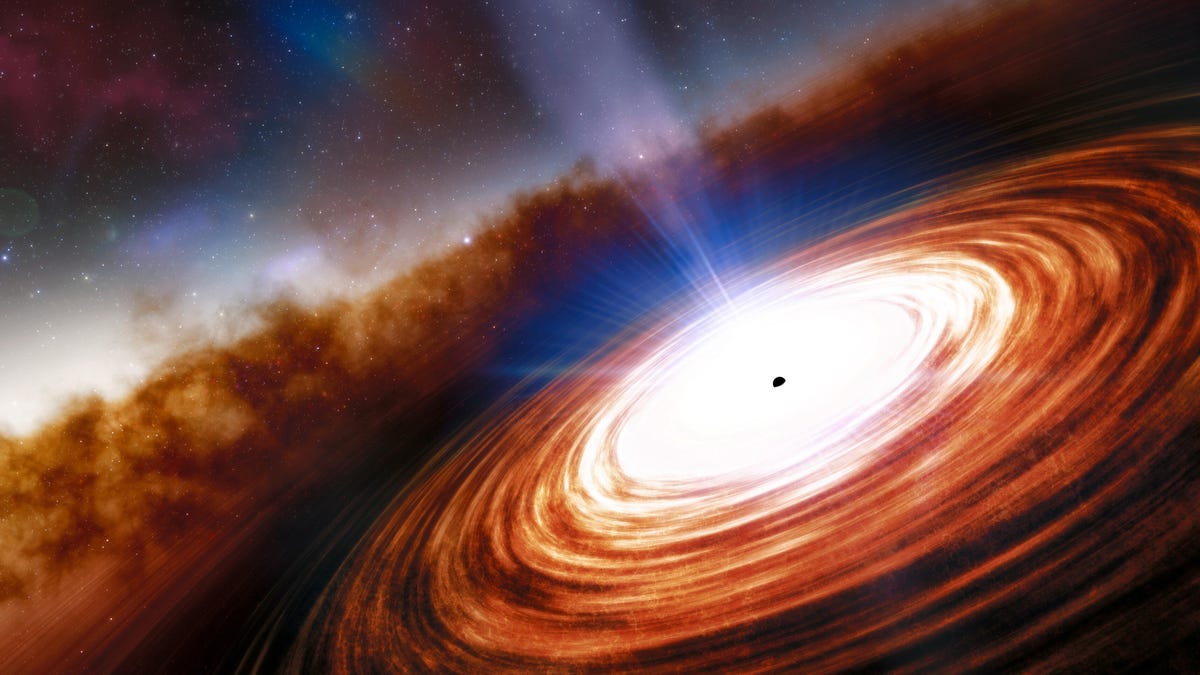Astronomers just found the oldest supermassive black hole yet
Just 670 million years after the Big Bang, a quasar with a monstrous black hole dominated a growing galaxy.

Just 670 million years after the Big Bang, the quasar J0313-1806 was born. It's the most distant black hole ever discovered.
A quasar has been discovered in a dark corner of space more than 13.03 billion light-years away, and it contains a supermassive black hole 1.6 billion times bigger than the sun at its heart.
Dubbed J0313-1806, the quasar, as we see it, is from a time when the universe was just 670 million years old, about 5% of its current age. At such a distance, J0313-1806 becomes the record holder for earliest black hole, dethroning the previous champion, J1342+0928, which was discovered in 2017 and existed when the universe was only 690 million years old.
The discovery, which was announced during the 237th Meeting of the American Astronomical Society on Tuesday, helps shed light on the environment in the ancient universe. But, like any good astrophysics story, it leaves researchers with a number of puzzling questions.
Quasars are extremely bright objects -- the brightest in the universe. They lie at the center of galaxies, but at their own center lies a supermassive black hole, millions to billions of times more massive than the sun. The intense gravity surrounding the black hole captures gas and dust and potentially even rips apart stars, leaving a trail of debris in a disk that encircles it. The debris whips around at incredible speed and expels extreme amounts of energy, which observers on Earth can see across the electromagnetic spectrum as bright light.
And it is bright.
J0313-1806, for instance, shines 1,000 times brighter than the entire Milky Way galaxy.
Astronomers were able to spot the quasar using a handful of ground-based observatories, including the Atacama Large Millimeter/submillimeter Array (ALMA) in Chile, the world's largest radio telescope, and two observatories on Mauna Kea in Hawaii. The observations enabled researchers to confirm the distance with high precision and examine some of the properties of the supermassive black hole at the quasar's center.
Their calculations put the mass of the black hole at around 1.6 billion times that of the sun. But this poses a problem. Because the black hole can not be older than 670 million years, traditional theories of black hole growth can't account for its size in such a short period of time. Our current understanding of black hole formation involves stars collapsing in on themselves, but the researchers say this would not be able to explain why J0313-1806's black hole is so huge.
"In order for the black hole to have grown to the size we see with J0313-1806, it would have to have started out with a seed black hole of at least 10,000 solar masses," said Xiaohui Fan, an astronomer at the University of Arizona and co-author on an upcoming paper describing the find. "That would only be possible in the direct collapse scenario."
That scenario posits that it's not a star that collapses into a black hole, but instead vast quantities of cold hydrogen gas in a cloud. The direct collapse theory is one of the ways to explain why astronomers find such massive black holes in the early universe, but it's not the only significant find for the team.
Using spectral data, the team also speculates that the supermassive black hole is gobbling up the equivalent of 25 suns every year -- which means it's still growing. "These quasars presumably are still in the process of building their supermassive black holes" said Fan.
The James Webb Space Telescope, which is slated to launch on Oct. 31, could help give scientists another window into the early universe, revealing how these supermassive beasts come to be.
The work has been accepted for publication in Astrophysical Journal Letters.
Follow CNET's 2021 Space Calendar to stay up to date with all the latest space news this year. You can even add it to your own Google Calendar .
Update: Clarification of age of the black hole versus the universe. A previous version of this article stated the black hole is only 670 million years old.

